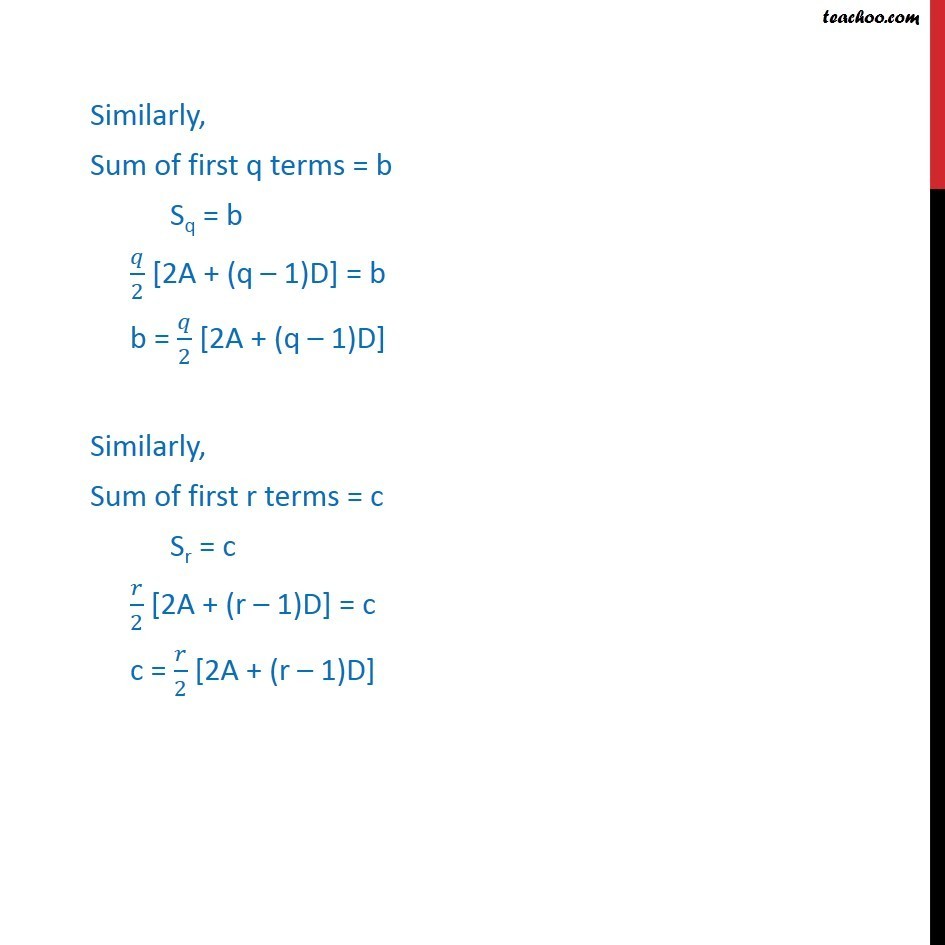






Arithmetic Progression
Question 2 Deleted for CBSE Board 2024 Exams
Question 3 Important Deleted for CBSE Board 2024 Exams
Question 4 Deleted for CBSE Board 2024 Exams
Question 5 Important Deleted for CBSE Board 2024 Exams
Question 6 Deleted for CBSE Board 2024 Exams
Question 7 Important Deleted for CBSE Board 2024 Exams
Question 8 Deleted for CBSE Board 2024 Exams
Question 9 Important Deleted for CBSE Board 2024 Exams
Question 10 Deleted for CBSE Board 2024 Exams
Question 11 Important Deleted for CBSE Board 2024 Exams You are here
Question 12 Deleted for CBSE Board 2024 Exams
Question 13 Deleted for CBSE Board 2024 Exams
Question 14 Important Deleted for CBSE Board 2024 Exams
Question 15 Important Deleted for CBSE Board 2024 Exams
Question 16 Important Deleted for CBSE Board 2024 Exams
Question 17 Deleted for CBSE Board 2024 Exams
Question 18 Important Deleted for CBSE Board 2024 Exams
Arithmetic Progression
Last updated at April 16, 2024 by Teachoo







Question11 Sum of first p,q,r terms of an A.P are a,b,c resp. "Prove that" a/p " (q r) + " b/q " (r p)+ " c/r " (p q) = 0" Here we have small a in the equation, so we use capital A for first term We know that, Sn = /2 [2A + (n 1)D] where Sn is the sum of n terms of A.P. n is the number of terms A is the first term, D is the common difference Given, Sum of first p terms = a Sp = a /2 [2A + (p 1)D] = a a = /2 [2A + (p 1)D] Similarly, Sum of first q terms = b Sq = b /2 [2A + (q 1)D] = b b = /2 [2A + (q 1)D] Similarly, Sum of first r terms = c Sr = c /2 [2A + (r 1)D] = c c = /2 [2A + (r 1)D] We need to "prove that" a/p " (q r) + " b/q " (r p)+ " c/r " (p q) = 0" We have a = p/2 [2A + (p 1)D] / = 1/2 [2A + (p 1)D] / = 1/2 (2A) + 1/2 (p 1)D / = A + (( 1))/2D Multiplying both sides by q r / (q r) = ("A + " (( 1))/2 "D" )(q r) Similarly, b = q/2 [2A + (q 1)D] / = 1/2 [2A + (q 1)D] / = 1/2 (2A) + 1/2 (q 1)D / = A + (( 1))/2D Multiplying both sides by r p / (r p) = ("A + " (( 1))/2 "D" )(r p) Similarly, c = r/2 [2A + (r 1)D] / = 1/2 [2A + (r 1)D] / = 1/2 (2A) + 1/2 (r 1)D / = A + (( 1))/2D Multiplying both sides by p q " " / "(p q) =" ("A + " (( 1))/2 "D" )(p q) We need to "prove that" a/p " (q r) + " b/q " (r p)+ " c/r " (p q) = 0" Taking L.H.S a/p " (q r) + " b/q " (r p)+ " c/r " (p q)" Putting values from (1), (2) & (3) = ("A + " (( 1))/2 "D" )"(q r) +" ("A + " (( 1))/2 "D" )"(r p) +" ("A + " (( 1))/2 "D" )"(p q)" = "[A(q r) + " 1/2 "(p 1)(q r)D]" +"[A(r p) +" 1/2 "(q 1)(r p)D]" "+ [A(p q) + " 1/2 "(r 1)(p q)D]" = "[A(q r) + A(r p) + A(p q)]" (" " @"+ " 1/2 " D[(p 1)(q r) + (q 1)(r p) + (r 1)(p q)] " ) = "A(q r + r p + p q)" "+ " 1/2 " D[pq pr q + r + qr pq r + p +rp rq p + q]" = ("A(q q r + r + p p) " ) "+ " 1/2 " D[pq qp + pr rp q + p + r r + p q + qr rq]" = ("A(0) " ) "+ " 1/2 " D[0]" = 0 + 0 = 0 = R.H.S Thus , L.H.S = R.H.S Hence proved